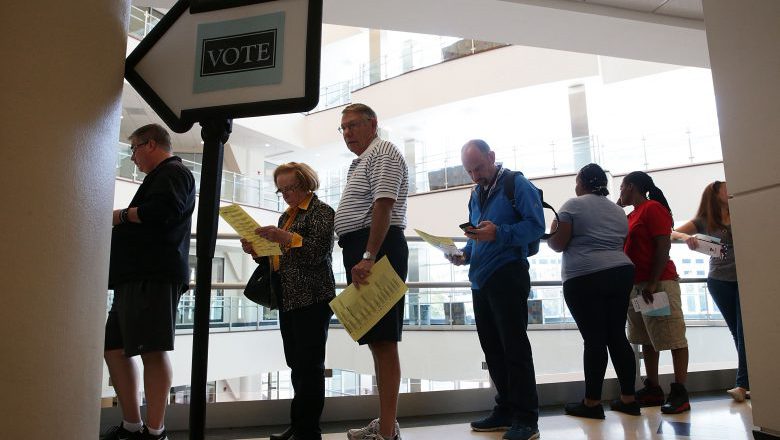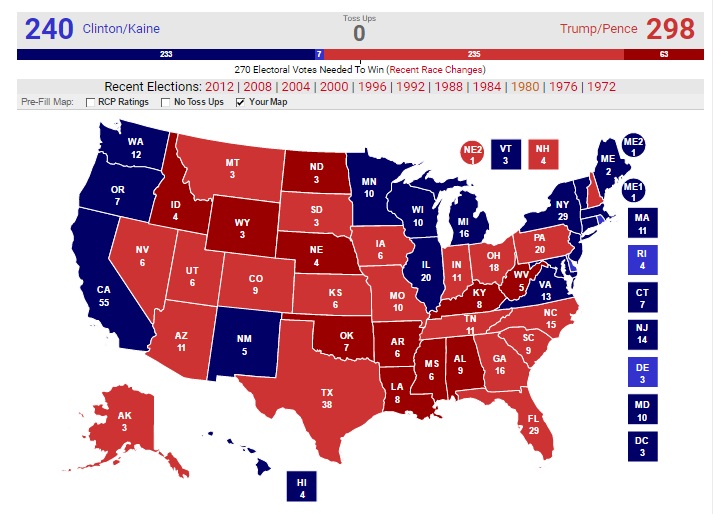
Did Donald Trump or Hillary Clinton have greater numbers at their Cedar Rapids Rally? (Getty)
It’s two days before the general election, and all eyes are on the battleground states that will determine the presidency. Who’s leading on November 6?
Eight battleground states are virtual ties, Hillary Clinton leads in 5, and Donald Trump leads in 1.
The RealClearPolitics polling averages show that Clinton leads Trump nationally by 2.2% in the four-way race. The race tightened fairly dramatically since October 28, but, since November 1, Clinton’s national polling averages have stabilized somewhat. Still, her national polling average lead is in the margin of error. It’s the battleground states that will determine the race, though.
The battlegrounds remain a tight race. Clinton lost ground in almost every battleground state since October 27, the day before FBI Director James Comey sent his initial letter to Congress saying the FBI wanted to review newly discovered emails. On Sunday, Comey sent another letter saying the agency is not referring charges, but, for days, Clinton’s numbers eroded. That means the candidates head into Election Day with deadlocked races in key states. Showing the shifting nature of the race, RealClearPolitics has now removed Georgia from the battleground poll list (Trump leads) and has added New Mexico, where Clinton leads, but it’s tighter.

Voters wait in line for casting their ballots during early voting for the 2016 general election at Forsyth County Government Center October 28, 2016 in Winston-Salem, North Carolina. (Photo by Alex Wong/Getty Images)
Here’s the tale of the tape for November 6:
Battleground states where the race is a virtual tie (a candidate leads by 3% or less) (8): Florida, Ohio, Nevada, North Carolina, Pennsylvania, Colorado, New Hampshire, Iowa.
Battleground states Trump leads (1): Arizona.
Battleground states Clinton leads (5): Michigan, Virginia, Wisconsin, Maine, New Mexico.
To show how tight the electoral college pathway remains for Trump, here is a map that gives Trump every battleground state where there is a virtual tie or that he leads.

Look promising for Trump? The challenge for him is that there is almost no margin for error. He can’t afford to lose many states. She can, although some states are more critical than others. Do the math, and give Florida to Clinton in the map above. The race ties (and goes into the House of Representatives). Give her Colorado and Pennsylvania (the race ties). (If he could take Maine’s Second Congressional District, though, the victor of which gets one elector, and where the race is virtually tied, he would win with the above scenarios).
But this entails winning almost every single deadlocked state – running the table. And in some of those, Clinton leads, just in the margin of error.
Give her Colorado, Pennsylvania, and any other deadlocked state in the map above (Nevada, where early returns have boded well for Clinton) or North Carolina, where she led until recently, or another, and Clinton wins. Give him Colorado but her Pennsylvania and North Carolina, and she wins. And so forth. She has many more combinations to get to the presidency.
Here are 9 possible election outcomes using electoral college maps.
Turnout is going to matter. Early voting does too. Forty million Americans have already voted. See a state-by-state breakdown of early voting tallies here. Early voting patterns, when compared to 2012, have been positive for Republicans in some key states, like Florida and North Carolina, and positive for Clinton in others, like Nevada and Colorado.
What’s going on at the battleground state level? Here’s what you need to know as of November 6:
Battleground States in the Margin of Error (3% lead or under)
Florida
Clinton leads Florida by an average of 1%, but that’s down slightly from the day before. Polling out of Florida has consistently shown the race to be deadlocked in this must-win state.
The most recent poll out of Florida, by CBS News, showed the race to literally be a tie. Clinton led 4 and 3, and Trump led by 4 in the most recent polls before that one. The CBS poll found Trump voters had higher enthusiasm than Clinton voters.
Half of voters felt Clinton’s emails were bad and worse than anything they had heard about Trump (the poll took place before the FBI director announced his agency won’t refer charges against Hillary for the newly discovered emails.) Another 15% felt the emails were bad but Trump was worse. Another 35% didn’t think the emails were a big deal. However, 62% didn’t think Trump was prepared to be president. Forty-two percent thought Trump had ties to the Russian government. In many ways, voters viewed both candidates negatively.
Early voting trends in Florida have shown positives for Republicans as they’ve closed the Democratic gap in early voting seen in 2012.
Ohio
Trump leads in Ohio, but, at 2.8%, the lead is in the margin of error for most polls. He’s led in all polls out of Ohio since the first James Comey letter to Congress, though – 1, 5 and 5.
The CBS poll showing him with a 1-point lead is the most recent, though. Clinton has recovered slightly in the polling average the past few days.
The results in this poll were similar to that in Florida, showing both candidates with high negatives, Trump with more enthusiasm, and Clinton’s emails upsetting just under half of voters. Early voting trends in Ohio have looked positive for the GOP.
Pennsylvania
Pennsylvania would be a critically important pick up for Trump. Clinton currently leads an average of 2.4% in the state.
That’s in the margin for error of most polls, and the most recent poll in the state, by Harper, found the race was a tie. Clinton led in the four polls before that one either 2 or 4 percentage points. Trump’s numbers are buoyed by the economic angst seen in western Pennsylvania, a state with only limited early voting.
You can see a detailed analysis of Pennsylvania and the presidential election here:
New Hampshire
Trump leads an average 1.6%, which is a big gain in the past week. However, the race is still in the margin of error for most polls.
The most recent poll, from Gravis, shows Trump up 2. The last four polls showed two ties and a Trump lead of 5 and 1.
New Hampshire remains very close, but recent polling has been good news for Trump. New Hampshire does not have wide open early voting.
North Carolina
Similar to New Hampshire, Trump now leads an average 1.5% in North Carolina, which is considered by most to be a must-win state for him.
That’s in the margin of error for most polls, though. There have been two polls since Comey’s first letter, and he leads by 5 and 7. Democrats have been concerned about African-American turnout in North Carolina, trends reflected in a smaller margin of Democratic early voting when compared to 2012.
Colorado
Clinton leads an average 2.9% in Colorado, which is a state that would help Trump dramatically if he could pick it up.
Of seven recent polls, though, two showed a tie, and the other 5 show Clinton leads of between 1-6 percentage points. Thus, Colorado still looks like Hillary’s to lose, but it’s gotten closer in the past weeks (Clinton led by 8 in mid-October). In recent days, Clinton’s average has stabilized there, though. Early voting trends in Colorado favor Democrats.
Nevada
Trump leads in Nevada by an average 2%, but that’s in the margin of error, and local news analysis of early voting trends has found they are favorable for Clinton.
The three most recent polls showed the race a tie, and Trump leading by 6 and 4. A surge in Latino turnout is keeping this one close in a state where most people early vote, and one local reporter who studies early voting patterns has reported that they will be very tough for Trump to surmount in a state Obama won by a healthy margin.
Iowa
Trump leads Iowa by an average of 3%. Recent polls have looked good for him out of Iowa.
The most recent poll, by the Des Moines Register, showed him leading by 7. Two other recent polls showed him up 3 and 1.
The newspaper said, “Trump leads among several key demographic groups, including men, self-identified independents, young and middle-aged voters and those without a college degree.” Early voting trends out of Iowa have looked promising for Trump.
Trump Leads
Arizona
Trump now has a healthy 4% average lead in Arizona, which has tightened in his favor after Clinton made this traditionally red state competitive due to Hispanic turnout.
Trump has led in all of the most recent Arizona polls, by 5, 5, 4, and 2.
Clinton Leads
Michigan
Donald Trump has been competing aggressively for Michigan, but Clinton still leads there by an average of 4%. Still, that’s down from 7% on November 1.
The most recent polls show Clinton leading by 3, 4, and 5. The margins are getting close to the margin of error, and Trump is hoping that turnout will benefit him. Michigan is not a state that allows everyone to early vote. Republicans say they have seen positive signs in the limited early voting the state allows.
Wisconsin
Clinton leads Wisconsin by a healthy 5.5% in RealClearPolitics polling averages. Trump recently cancelled a rally he was going to give in Wisconsin on November 6 in favor of events in Minnesota, Michigan, and Virginia instead.
Wisconsin tends to vote Democratic in presidential years, although it has a Republican governor. There hasn’t been a lot of polling out of Wisconsin, but the last three polls showed Clinton up 6, 6, and 4. Early voting shows some positive signs for Democrats in Wisconsin.
Virginia
Clinton leads by an average of 5.2 percentage points in Virginia, the home of her running mate Tim Kaine.
She led by 8 on October 30, and the race then tightened in Trump’s favor. However, more recently, her polling average has ticked back up. She led in the 5 most recent polls from 4-7 percentage points.
Maine
Clinton leads Maine by an average of 4.5%, but there’s a catch. Maine gives out some electors to the winners of Congressional districts, and a poll showed the race virtually tied in the Second.
Although the race has tightened in Maine as a whole, Clinton led by 4 and 5 in the recent polling.
New Mexico
Clinton leads in New Mexico by an average 4%. However, the state hasn’t normally been on battleground lists. RealClearPolitics added the state to the battlegrounds as it has been tightening in Trump’s favor.
Clinton leads by 5 and 3 in the most recent polling.
Read more about Donald Trump and Melania in Spanish at AhoraMismo.com:




